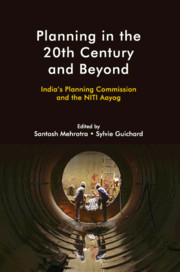Book contents
- Frontmatter
- Contents
- List of Figures
- List of Tables
- List of Abbreviations
- 1 Planning for a 21st Century India
- Part I Origins: Ideas and Ideology
- 2 From Economists to Historians: Studying the Planning Commission, 1950–2014
- 3 The Long Road to Indian Economic Planning (until 1950)
- 4 Ideas and Origins of the Planning Commission in India
- Part II Changes and Continuity: Development and Adaptation of Planning and the Planning Commission
- 5 The Planning Commission and Education
- 6 Addressing Agrarian Distress: Sops versus Development
- 7 Economic Planning after Economic Liberalization: Between Planning Commission and Think Tank NITI, 1991–2015
- 8 Planning Commission: Obiter Dictum
- 9 On a Revived Planning Commission
- Part III Planning Beyond the Planning Commission
- 10 Make in India
- 11 Manufacturing: The Cornerstone of a Planning Strategy for the 21st Century
- 12 Fiscal Planning to Sustain Growth and Poverty Reduction
- 13 Plan, but Do Not Over-plan: Lessons for NITI Aayog
- 14 Why Does India Need a Central Planning Institution in the 21st Century?
- Notes on Contributors
- Index
- References
5 - The Planning Commission and Education
Published online by Cambridge University Press: 04 April 2020
- Frontmatter
- Contents
- List of Figures
- List of Tables
- List of Abbreviations
- 1 Planning for a 21st Century India
- Part I Origins: Ideas and Ideology
- 2 From Economists to Historians: Studying the Planning Commission, 1950–2014
- 3 The Long Road to Indian Economic Planning (until 1950)
- 4 Ideas and Origins of the Planning Commission in India
- Part II Changes and Continuity: Development and Adaptation of Planning and the Planning Commission
- 5 The Planning Commission and Education
- 6 Addressing Agrarian Distress: Sops versus Development
- 7 Economic Planning after Economic Liberalization: Between Planning Commission and Think Tank NITI, 1991–2015
- 8 Planning Commission: Obiter Dictum
- 9 On a Revived Planning Commission
- Part III Planning Beyond the Planning Commission
- 10 Make in India
- 11 Manufacturing: The Cornerstone of a Planning Strategy for the 21st Century
- 12 Fiscal Planning to Sustain Growth and Poverty Reduction
- 13 Plan, but Do Not Over-plan: Lessons for NITI Aayog
- 14 Why Does India Need a Central Planning Institution in the 21st Century?
- Notes on Contributors
- Index
- References
Summary
The question examined here is whether the Planning Commission (PC) played any role in shaping education policy, and if so what and in what ways. It is suggested that the PC did indeed play an important role in two periods: first in the 1950s and 1960s in influencing the educational architecture that developed post- Independence and then in the 1990s with the strong support it gave to proposals for greater private investment in education. In between these two periods, it is more difficult to find a clear ‘PC’ influence separate from the thinking of education experts and the Ministry, later Department, of Education.
The PC had an Education Division to co-ordinate consultations on education and develop the relevant plan chapter. According to the PC itself, the Education Division had to perform the following functions:
i. Formation of long-term, medium-term and annual plans for the Central and the State/Union Territories levels, defining the phases in which they should be implemented, assigning their inter-se priorities and resource allocation;
ii. Coordination of the education plans of the States/Union Territories and the central agencies including the University Grants Commission and the National Council of Education Research and Training as well as of the national-educational plan with the development plans in other sectors, assessing and indicating adjustments needed in the plan policies, programmes and priorities so as to achieve national goals and objectives;
iii. In support of the above functions, maintain educational statistics and undertake/promote/support research studies and surveys covering –
(a) Generation, collection, compilation and analysis of data and relevant information
(b) Programme evaluation and prognosis and
(c) Alternative and/or supplementary measures and new policy initiatives in the field of education;
iv. Collaborate with and/or advise/assist the concerned Government Departments, international organizations and other agencies like NIEPA [National Institute of Educational Planning and Development], NCERT [National Council for Educational Research and Training], UGC [University Grants Commission ][…]; and
v. Examine resource mobilization and low cost strategies/alternatives and make recommendations in this regard;
vi. Review of Committees and Commissions, Central Advisory Boards and Annual/five-year plan;
vii. The technical staff of the Division is also working on the Educational Statistics received from the MHRD [Ministry of Human Resource Development], and the Department of Statistics and other agencies.
Experts participated in the formulation of education plan through membership of the working and steering groups relating to the education sector.
- Type
- Chapter
- Information
- Planning in the 20th Century and BeyondIndia's Planning Commission and the NITI Aayog, pp. 91 - 109Publisher: Cambridge University PressPrint publication year: 2020



